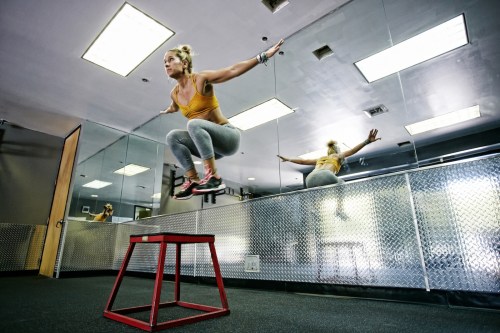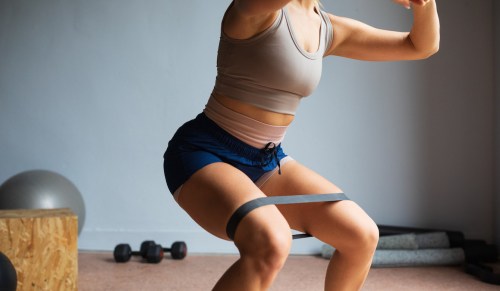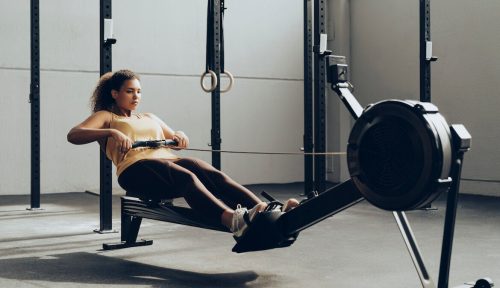I judge whether or not I’m getting a good workout by a number of things: how much I’m sweating, how out of breath I am, or how sore I am the next day. During the sweat sesh, I’m also measuring how much weight I’m able to lift, and, if I’m running, how many miles I can log. But I’ve never ever thought about how much power I’m exerting—which is apparently an important factor to consider.
Power, as I’m learning, is essentially a way-underrated measurement when it comes to exercise. “Power is the ability to do the same operation explosively, which means rapidly,” says Vince Sant, lead trainer and co-founder of V Shred. “It’s best visualized by how much energy you can compress into a minuscule amount of time while performing a fitness move.” In other words, power is “the ability to exert maximum force in the shortest amount of time,” explains Gerren Liles, a fitness trainer and instructor with Mirror.
How (and why, exactly) should you be incorporating power exercises in your own fitness regimen? I asked pros for the juice.
The importance of power
Power sounds like it’s the same thing as strength, but Sant points out that the two are different things in fitness. “Power is often confused with strength,” he says. “Strength is the capacity your muscles have to lift, pull, or push a certain amount of weight.” The power factor comes in handy IRL, though, in a slightly different way. “Most workouts and sports demand power output, be it jumps, sprints, or burpees,” says Liles. “Training for power not only translates to better sports performance, but it can carry over to mundane daily experiences that demand high effort, like running for a bus or hopping over an object.”
“Training for power not only translates to better sports performance, but it can carry over to mundane daily experiences that demand high effort.” —Gerren Liles
It’s kind of like a hardcore enhancement for your workout. “Power in terms of plyometrics is another way to enhance your fitness regimen,” says Sant. “Training for power in a bodyweight setting has been shown to produce healthy gains in strength and capacity for power output. Power training will put added focus on speed.” While he doesn’t recommend working with power to gym newbies, Sant prefers doing power work after a solid warm-up but before any strenuous weight session “because plyometrics are incredibly dependent on form, and if the form is sacrificed because of muscle fatigue, you’re risking an injury.”
Becoming more powerful
Now that that’s cleared up, here’s the deal with adding more power into your workout: It’s going to take some leveling up. “If you’ve never experimented with adding power to your fitness routine, don’t start by performing explosive lifts on your maximum weight,” says Sant. “Instead, try incorporating plyometrics into your bodyweight HIIT workouts. Think explosive push-ups, jump squats, squat thrusters, and long jumps.” He says that this way, you’ll get familiar with the feeling of explosive moves and get more comfortable with big energy outputs in periods of almost split seconds.
It’s really hard to measure how much power you’re exerting though, unless you’re in some type of lab. “If you’re beginning with bodyweight workouts and are not in a lab wired to a bunch of machines checking the activity in your muscles, it’d be hard to get exact measurements of your power output,” says Sant. “Though you can always observe how much resistance you’re performing a move under—whether bodyweight or free weights—and the amount of reps you can do in a given amount of time per set, and how many sets you can perform.” If you’re increasing in each category, and the reps are getting quicker, you’re improving.
Liles notes that you can measure your power, in a way, by identifying the markers for high performance in the chosen activity it demands. “You can measure height and speed, for example, by testing out your max height for box jumps, or a 100-yard dash for time,” he explains. “Generally speaking though, simply being able to execute a plyometric move correctly and possibly for an extended time (endurance) is enough for the average person.”
One thing to keep in mind is that before testing your body’s power, check your muscles: “Make sure that your mobility and flexibility are on point so you can move through full range of motion safely and without compensation,” says Liles. Also key? Form. “Remember, you must start by learning proper form and stabilizing your core,” says Sant. “After you’ve been able to increase reps and sets in the right form of a particular movement, then you can graduate into power variations of the movements and grow from there.”
When to use power in workouts
Before you start channeling Superwoman in your workouts though, hold up. Both Sant and Liles advise against incorporating power into every workout. “All workouts are not the same and fitness programs should always rely on a balance of training techniques to reach your individual goals,” says Sant. “Dedicate a portion of your training plan to max power output, but not all of it.”
Liles echoes that sentiment, noting that you shouldn’t even train everyday. “Power is often demanded in HIIT workouts. In order to have a balanced training regimen, incorporating strength training is necessary,” he says. “Strength is applying maximal force against a load of resistance. You also need recovery days, or days where you’re working on mobility and flexibility.” So don’t halt the yoga practice.
It’s also important to keep working on your strength training, because it’s an essential part of using power. “Strength training helps to build up your fast-twitch muscle fibers, which are necessary for movements that require force and strength,” says Liles. “One way to get better at expressing power is to actually have a modality or activity in which you practice repeatedly and see improvement. You get better at running by running, jumping by jumping, etc.” Practice makes power.
Ready to give it a shot? Try this power workout:
Sign Up for Our Daily Newsletter
Get all the latest in wellness, trends, food, fitness, beauty, and more delivered right to your inbox.
Got it, you've been added to our email list.











